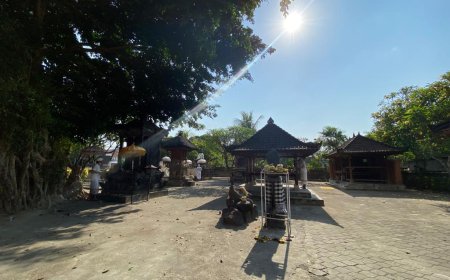Unraveling the Mystery of Pura Goa Raja Taksaka: A Spiritual Trail in Tabanan
Goa Raja Temple, hidden in Tabanan, Bali, is a sacred and mysterious place of worship, known to few. Located 10 meters underground, it is called a "hidden gem" and resembles Goa Giri Putri in Nusa Penida, with statues and a clear water spring. Jro Mangku Sruti, the temple’s guardian, once protected it from a housing project. Today, Goa Raja is recognized by Hindus and spiritual practitioners as a site for meditation and pilgrimage, with a history believed to date back to prehistoric times.

Statues and offerings can be seen inside Goa Raja Taksaka Temple, a sacred site believed to possess spiritual power by Hindus in Tabanan. This place is used for meditation and spiritual rituals, surrounded by a mystical aura that makes it deeply sacred.
Located in Banjar Gerokgak Gede, Desa Delod Peken, Tabanan, Pura Goa Raja Taksaka has become an increasingly popular spiritual destination for Hindus and spiritual practitioners. This temple was accidentally discovered by Mangku Rawet in 1980 after he experienced a miraculous event. Mangku Rawet fell into a seven-meter deep ravine in front of his house, but strangely, as his body nearly touched the bottom, he felt as if something was supporting him, preventing any pain despite losing consciousness. Upon regaining consciousness, Mangku Rawet saw a cave on the west side of the ravine. His curiosity led him to enter the cave, where he found the ruins of a shrine that marked the beginning of the construction of Pura Goa Raja Taksaka.
Gua Raja Taksaka (Sumber: Koleksi Pribadi)
The entrance to Goa Raja Taksaka Temple, located underground, is adorned with guardian statues dressed in black and white checkered cloth. The stone steps leading into the cave reveal the natural and magical atmosphere that envelops the surrounding area.
Mangku Rawet and his wife, Ni Wayan Putri, then performed a ritual inside the cave and felt the presence of a large, hairy spiritual being. Shortly after, Mangku Rawet suffered an accident that caused his leg to break. His wife then made a vow in front of the shrine ruins in the cave, asking for her husband’s healing with a promise to restore the shrine and hold a pujawali every 210 days. Thanks to their prayers and vows, Mangku Rawet fully recovered, and they fulfilled their vow by building a shrine in the cave and conducting a purification ceremony.
After the purification ceremony, a nunas bawos was conducted to discover the name and the spiritual inhabitants residing in Pura Goa Raja Taksaka. It was revealed that the temple is home to Ida Ratu Biyang Sakti and Ratu Niang Sakti, and the temple officially became known as Pura Goa Raja Taksaka. This site is believed to have a close spiritual connection with Pura Goa Giri Putri in Nusa Penida.
Lingga (Sumber: Koleksi Pribadi)
The exterior of Luhur Ulun Goa Temple can be seen with a sign displaying 'Dalem Raja Taksaka.' In front of it, there is a sacred symbol wrapped in black and white cloth as a sign of spiritual guardianship. The temple's surroundings are shaded by lush trees, creating a peaceful and sacred atmosphere.
Worship at Pura Goa Raja Taksaka begins with prayers at the shrine of Ratu Dalem Gumi located in the outer area, followed by descending into the ravine to enter the cave. Inside the cave, there is Pura Beji, situated about ten meters from the entrance. Prayers are also conducted at the shrines of Ratu Lingsir and Ibu Dewi Kwam In, which are located in another cave. Finally, worshippers perform prayers at Palinggih Ageng, the main shrine within the temple.
Although it is primarily maintained by Mangku Rawet and his family, Pura Goa Raja Taksaka is now increasingly visited by Hindus and spiritual practitioners, both from Bali and beyond. Each pujawali held on Buda Kliwon, this temple witnesses spiritual miracles and a cultural heritage that continues to be preserved. The cave not only serves as a place of worship but also as a center for inner peace for those who come to meditate and seek spiritual guidance.





























































